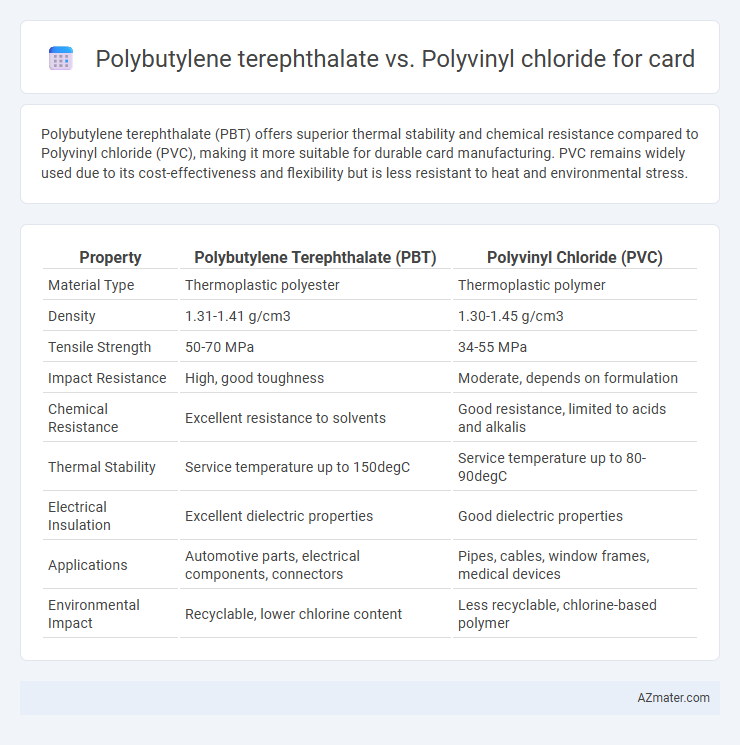Polybutylene terephthalate (PBT) offers superior thermal stability and chemical resistance compared to Polyvinyl chloride (PVC), making it more suitable for durable card manufacturing. PVC remains widely used due to its cost-effectiveness and flexibility but is less resistant to heat and environmental stress.
Table of Comparison
| Property | Polybutylene Terephthalate (PBT) | Polyvinyl Chloride (PVC) |
|---|---|---|
| Material Type | Thermoplastic polyester | Thermoplastic polymer |
| Density | 1.31-1.41 g/cm3 | 1.30-1.45 g/cm3 |
| Tensile Strength | 50-70 MPa | 34-55 MPa |
| Impact Resistance | High, good toughness | Moderate, depends on formulation |
| Chemical Resistance | Excellent resistance to solvents | Good resistance, limited to acids and alkalis |
| Thermal Stability | Service temperature up to 150degC | Service temperature up to 80-90degC |
| Electrical Insulation | Excellent dielectric properties | Good dielectric properties |
| Applications | Automotive parts, electrical components, connectors | Pipes, cables, window frames, medical devices |
| Environmental Impact | Recyclable, lower chlorine content | Less recyclable, chlorine-based polymer |
Introduction to Polybutylene Terephthalate and Polyvinyl Chloride
Polybutylene terephthalate (PBT) is a thermoplastic polyester known for its high strength, chemical resistance, and excellent electrical insulating properties, making it ideal for durable and heat-resistant card applications. Polyvinyl chloride (PVC) is a versatile polymer commonly used in card manufacturing due to its flexibility, affordability, and ease of processing, but it exhibits lower heat resistance and environmental concerns compared to PBT. The choice between PBT and PVC for cards depends on specific requirements such as durability, environmental impact, and performance under thermal stress.
Chemical Structure and Properties Comparison
Polybutylene terephthalate (PBT) features a semi-crystalline structure with repeating ester linkages, giving it excellent chemical resistance, high tensile strength, and thermal stability suitable for card manufacturing. Polyvinyl chloride (PVC) consists of a vinyl chloride monomer with a rigid, amorphous polymer chain that offers good flexibility, chemical inertness, and impact resistance but lower thermal tolerance compared to PBT. The ester functional groups in PBT contribute to superior dimensional stability and resistance to solvents, whereas the chlorine atoms in PVC provide flame retardancy and enhanced resistance to weathering.
Mechanical Strength: PBT vs. PVC
Polybutylene terephthalate (PBT) exhibits superior mechanical strength compared to polyvinyl chloride (PVC), making it a preferred material for cards requiring enhanced durability and rigidity. PBT offers higher tensile strength and impact resistance, which ensures better performance under stress and prolonged use. In contrast, PVC tends to be more flexible but lacks the same level of structural integrity, limiting its application where mechanical robustness is critical.
Durability and Longevity for Card Applications
Polybutylene terephthalate (PBT) offers superior durability and longevity over polyvinyl chloride (PVC) in card applications due to its high resistance to wear, chemical exposure, and heat. PBT's excellent mechanical strength and thermal stability ensure cards maintain structural integrity and appearance over extended use, reducing the risk of cracking or warping commonly seen with PVC. These properties make PBT an ideal choice for long-lasting cards in demanding environments.
Printability and Surface Finish Quality
Polybutylene terephthalate (PBT) offers superior printability compared to polyvinyl chloride (PVC) due to its smooth, glossy surface and excellent dimensional stability, which ensures crisp, high-resolution images on cards. PBT's low moisture absorption and resistance to ink solvents prevent smudging and blurring, enhancing long-term print durability. In contrast, PVC surfaces often require additional coatings to improve print adhesion and surface finish, resulting in variability in glossiness and texture quality.
Environmental Impact and Sustainability
Polybutylene terephthalate (PBT) offers superior environmental benefits over polyvinyl chloride (PVC) due to its recyclability and lower toxic emissions during production and disposal. PBT's biodegradability and lower carbon footprint contribute to enhanced sustainability in card manufacturing, while PVC production releases harmful dioxins and contains chlorine, posing risks to ecosystems and human health. Consequently, PBT represents a more eco-friendly choice for sustainable card materials, aligning with increasing regulatory restrictions on PVC usage.
Cost Effectiveness and Manufacturing Considerations
Polybutylene terephthalate (PBT) offers superior dimensional stability and higher heat resistance compared to polyvinyl chloride (PVC), resulting in better long-term performance for card manufacturing. PBT's processing temperatures range from 220degC to 250degC, which require more energy than PVC's 160degC to 190degC, impacting manufacturing costs but enabling faster cycle times and lower scrap rates. Despite higher raw material costs, PBT's enhanced durability and recyclability create cost-effective benefits over PVC, especially for high-performance or environmentally sensitive card applications.
Resistance to Heat, Chemicals, and Wear
Polybutylene terephthalate (PBT) exhibits superior resistance to heat, maintaining stability at continuous temperatures around 130degC, compared to polyvinyl chloride (PVC), which softens near 80degC. PBT demonstrates excellent chemical resistance against hydrocarbons, oils, and solvents, whereas PVC is vulnerable to certain solvents and alkalis. In terms of wear resistance, PBT's high mechanical strength and low friction coefficient provide better durability for card applications than the more brittle and abrasion-prone PVC.
Common Use Cases and Industry Preferences
Polybutylene terephthalate (PBT) is preferred in the electronics and automotive industries for card applications due to its excellent electrical insulation properties, heat resistance, and mechanical strength. Polyvinyl chloride (PVC) remains widely used in credit cards, ID cards, and membership cards because of its cost-effectiveness, ease of printing, and durability against wear and tear. Industry preferences favor PBT for high-performance or specialized cards requiring thermal stability, while PVC dominates mass production of standard plastic cards.
Conclusion: Selecting the Right Material for Cards
Polybutylene terephthalate (PBT) offers superior chemical resistance, thermal stability, and mechanical strength, making it ideal for durable, high-performance cards. Polyvinyl chloride (PVC), while cost-effective and widely used, is less resistant to heat and chemicals, often resulting in shorter card lifespan. For applications requiring robust durability and environmental stability, PBT is the preferred choice, whereas PVC suits budget-sensitive projects with moderate performance needs.

Infographic: Polybutylene terephthalate vs Polyvinyl chloride for Card
 azmater.com
azmater.com